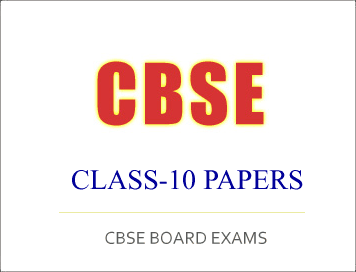CBSE PORTAL : CBSE Class-10 Exam 2019 : All India Scheme Question Paper-Introduction of Financial Market | |
- CBSE Class-10 Exam 2019 : All India Scheme Question Paper-Introduction of Financial Market
- CBSE Class-10 Exam 2019 : All India Scheme Question Paper-E-Publishing and E-Office
- CBSE Class-10 Exam 2019 : All India Scheme Question Paper-Food Production
- CBSE Class-10 Exam 2019 : All India Scheme Question Paper-Elements of Book Keeping and Accountancy
- (Download) CBSE: Class XII Textile Chemical Processing Question Paper - 2019
- (Download) CBSE: Class XII Traditional Indian Textile Question Paper - 2019
- (Download) CBSE: Class XII Capital Market Operations Question Paper - 2019
- (Download) CBSE: Class XII Database Management Application Question Paper - 2019
| CBSE Class-10 Exam 2019 : All India Scheme Question Paper-Introduction of Financial Market Posted: 10 Jun 2019 02:25 AM PDT |
| CBSE Class-10 Exam 2019 : All India Scheme Question Paper-E-Publishing and E-Office Posted: 10 Jun 2019 02:14 AM PDT |
| CBSE Class-10 Exam 2019 : All India Scheme Question Paper-Food Production Posted: 10 Jun 2019 01:30 AM PDT |
| CBSE Class-10 Exam 2019 : All India Scheme Question Paper-Elements of Book Keeping and Accountancy Posted: 10 Jun 2019 01:16 AM PDT |
| (Download) CBSE: Class XII Textile Chemical Processing Question Paper - 2019 Posted: 09 Jun 2019 11:07 PM PDT
Question Papers For Board Examinations 2019Class – XIISubject – Textile Chemical ProcessingSubject : Textile Chemical Processing Class : XII Year : 2019 General Instructions : (i) This question paper contains 20 questions. SECTION A
SECTION B
(iii) Illustrate your answers wherever possible. Questions :SECTION AMatch any ten of the following : (i) Impurity in wool (a) Guar gum Very Short Answer Type Questions (Any five) 2. What is the use of Desizing ? Click Here To Download Full Paper<< Go Back To Main PageCourtesy: CBSE |
| (Download) CBSE: Class XII Traditional Indian Textile Question Paper - 2019 Posted: 09 Jun 2019 10:58 PM PDT
Question Papers For Board Examinations 2019Class – XIISubject – Traditional Indian TextileSubject : Traditional Indian Textile Class : XII Year : 2019 General Instructions : (i) All sections are compulsory. Questions :SECTION A1. Explain the following terms in 1 – 2 sentence each. (Do any five) 2. Fill in the blanks. (Do any five) Click Here To Download Full Paper<< Go Back To Main PageCourtesy: CBSE |
| (Download) CBSE: Class XII Capital Market Operations Question Paper - 2019 Posted: 09 Jun 2019 10:43 PM PDT
Question Papers For Board Examinations 2019Class – XIISubject – Capital Market OperationsSubject : Capital Market Operations Class : XII Year : 2019 General Instructions : (i) This question paper contains 33 questions out of which the candidate needs to attempt only 25 questions. SECTION A
SECTION B
(iii) All questions of a particular section must be placed in the correct order. Questions :SECTION AAttempt any 10 questions. 1. How can you invest in primary market ? 2. What is private placement of the New Issues ? 3. What does ‘Market Capitalisation Ratio’ measure ? 4. Define ‘Dominant Promoter Group’. 5. State the role of authorized dealer in the capital market. 6. List the documents required to affiliate the Sub-Broker under Trading Member (Broker). 7. What is meant by VSAT Trading Accessory ? 8. Give the meaning of capping of margin in ‘Buy Transaction’. 9. Define ‘Cross Margining’. 10. How is Extreme Loss Margin collected ? 11. Define ‘Systemic Risk’. 12. Define ‘Insider’ according to the provisions of SEBI (Prohibition of Insider Trading) Regulations, 1992. Click Here To Download Full Paper<< Go Back To Main PageCourtesy: CBSE |
| (Download) CBSE: Class XII Database Management Application Question Paper - 2019 Posted: 09 Jun 2019 10:38 PM PDT
Question Papers For Board Examinations 2019Class – XIISubject – Database Management ApplicationSubject : Database Management Application Class : XII Year : 2019 General Instructions : (i) This question paper contains 31 questions, out of which the candidate needs to attempt only 23 questions. SECTION A
SECTION B
Questions :SECTION AMultiple Choice Questions (Choose the most appropriate option). Attempt any ten questions from the following : 1x10=10 1. The set of all possible values that an attribute may contain is called the ___________ of an attribute. 1 2. If x = 20, y = 10, what will be the value of x, if we write the statement x += y ? 1 3. Identify the operator that performs pattern searching in MYSQL. 1 4. Which of the following is not a DDL statement ? 1 5. The term used to describe the information, systems and applications that support and drive business processes, most often using web technologies, is called 1 6. Which one of the following is not a search engine ? 1 7. Which of the following is an SQL aggregate function ? 1 8. Which SQL statement is used to update data in a database ? 1 9. An expression involving byte, int and literal numbers is promoted to which 10. Which of these is an incorrect statement ? 1 11. What is the output of relational operators ? 1 12. An example of broadcasting model of E-governance is _____________. 1 Click Here To Download Full Paper<< Go Back To Main PageCourtesy: CBSE |
| You are subscribed to email updates from CBSE PORTAL : CBSE, ICSE, NIOS, JEE-MAIN, AIPMT Students Community. To stop receiving these emails, you may unsubscribe now. | Email delivery powered by Google |
| Google, 1600 Amphitheatre Parkway, Mountain View, CA 94043, United States | |


No comments:
Post a Comment